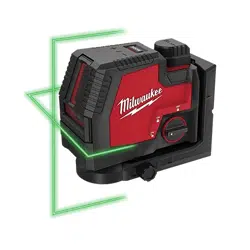Loading ...
Loading ...
Loading ...

8
d
9. The maximum vertical deviation (d) is: dmax = 2X
H (door opening) x ±1/8" ÷ 33'.
Example: for a door opening height of 7', the
maximum permitted deviation (d) is: dmax = 2 x
7' x ±1/8" ÷ 33' = ±0.05".
Therefore, the measurement between points III
and IV on the upper door opening should not
exceed 0.05" in a 7' doorway.
Plumb Dot Accuracy (3522-20)
A free measuring distance of approximately 33' be-
tween oor and ceiling on a rm surface is required
for this check. It is suggested to install riser block, if
not already equipped.
1. Place the tool within 1' of the oor.
Turn the tool to
ON and to Perpendicular
Level & Plumb Lines Mode.
2. Set tool on ground and mark the center of the
plumb point on the ceiling (point I). Also, mark the
center of the plumb point on the oor (point II).
16.5'
3. Rotate the tool 180°. Align the center point of the
laser beam directly onto the oor point II.
4. Mark the center of the top plumb point on the
reference line on the ceiling (point III).
d
5. The distance between points I and III on the ceiling
is the deviation (d) of the tool. This distance should
not exceed 1/8" (max.) at 33'.
For the Measuring distance of 2 x 16.5' = 33', the
maximum allowable deviation (d) is: 33' x ±1/8" ÷
33' = ±1/8".
MAINTENANCE
WARNING
To reduce the risk of injury, always
remove the battery before perform-
ing any maintenance. Never disassemble the tool.
Maintain Laser Level
Maintain tools. If damaged, have the tool repaired
before use. Accidents may be caused by poorly
maintained tools.
WARNING
To reduce the risk of personal in-
jury and damage, never immerse
your tool in liquid or allow a liquid to ow inside
them.
Cleaning
Clean dust and debris from any vents. Keep tool
clean, dry and free of oil or grease. Use only mild
soap and a damp cloth to clean, since certain clean-
ing agents and solvents are harmful to plastics
and other insulated parts. Some of these include
gasoline, turpentine, lacquer thinner, paint thin-
ner, chlorinated cleaning solvents, ammonia and
household detergents containing ammonia. Never
use ammable or combustible solvents around tools.
Cleaning the Lenses
Blow o loose particles with clean compressed air.
Carefully wipe the surface with a cotton swab moist-
ened with water.
Repairs
For repairs, return the tool, battery pack and charger
to the nearest authorized service center.
ACCESSORIES
WARNING
Use tools only with specifically
designated accessories. Use of any
other accessories may create risk of injury.
Loading ...
Loading ...
Loading ...
